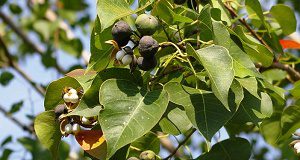Of the more than 4,000 known plant species growing in Florida, approximately 30% are not native to Florida or the Southeast, and in the US invasive exotic species cost an estimated $120 billion each year in damages. Early detection and removal of invasive plants is the key to successful management. This publication describes many of the current methods used in north Florida forest operations to manage invasive exotic plants. It also provides references for additional sources of information. Written by Chris Demers, Patrick Minogue, Michael Andreu, Alan Long, and Rick Williams.
http://edis.ifas.ufl.edu/fr133
Tag: Rick Williams
Controlling Invasive Exotic Plants in North Florida Forests (SSFOR19/FR133)
 Invasive non-native organisms are one of the greatest threats to the natural ecosystems of the United States. Invasive plants reduce biodiversity, encroach on endangered and threatened species, and rob native species of habitat. This 8-page fact sheet describes many of the current methods used to manage some of the more common and troublesome invasive exotic plants in north Florida forests. Written by Chris Demers, Alan Long and Rick Williams, and published by the UF Department of School of Forest Resources and Conservation, January 2012.
Invasive non-native organisms are one of the greatest threats to the natural ecosystems of the United States. Invasive plants reduce biodiversity, encroach on endangered and threatened species, and rob native species of habitat. This 8-page fact sheet describes many of the current methods used to manage some of the more common and troublesome invasive exotic plants in north Florida forests. Written by Chris Demers, Alan Long and Rick Williams, and published by the UF Department of School of Forest Resources and Conservation, January 2012.
http://edis.ifas.ufl.edu/fr133
A Native Growing Season Forage for Wildlife: Teaweed, Sida acuta Burm. f. (FOR114/FR168)

What is teaweed and why would anyone want to learn more about this plant? Teaweed has been a problem plant in agriculture, but it has many good qualities as a wildlife food source. Anyone interested in growing plants that benefit native wildlife, especially white-tailed deer, turkeys and quail, can improve wildlife habitat by managing native plants. Sida acuta was identified as a native plant that provides food and/or cover to several species of wildlife. This 4-page fact sheet was written by Rick Williams and Tim Baxley, and published by the UF Department of School of Forest Resources and Conservation, May 2011. (Photo by Dinesh Valke
http://edis.ifas.ufl.edu/fr168
Pre-Commercial Thinning Loblolly Pines: Does It Pay? (FOR188/FR243)

The decision to pre-commercially thin a stand is often difficult for many landowners because of the costs involved with implementing this treatment. It is costly but, when applied properly, it is a financially attractive investment. It is performed before trees reach merchantable size, to reduce densities in overstocked stands and improve the growth of the remaining trees. This 6-page fact sheet was written by R. Williams, K. Bohn, J. McKeithen and C. Demers, and published by the UF Department of School of Forest Resources and Conservation, May 2011.
http://edis.ifas.ufl.edu/fr243
FOR218/FR280 Biology and Control of Japanese Climbing Fern (Lygodium japonicum)
FOR-218, a 7-page illustrated fact sheet by Patrick J. Minogue, Stella Jones, Kimberly K. Bohn, and Rick L. Williams, describes this non-native, invasive vine which is widespread in damp areas in north and West Florida — its biology and control measures. Includes references. Published by the UF School of Forest Resources and Conservation, May 2009.
http://edis.ifas.ufl.edu/FR280
FOR-188/FR243 Pre-Commercial Thinning Loblolly Pines ? Does It Pay?
FOR-188, a 5-page illustrated fact sheet by Williams, R.A., K. Bohn and J. McKeithen, describes methods and silvicultural and economic benefits for reducing tree density before the trees reach merchantable size. Includes references. Published by the UF School of Forest Resources and Conservation, June 2008.
http://edis.ifas.ufl.edu/FR243
SS-FOR19/FR133 Controlling Invasive Exotic Plants in North Florida Forests
Revised! SS-FOR-19, an 8-page fact sheet by Chris Demers, Alan Long and Rick Williams, describes many of the current methods being used to manage some of the more common and troublesome invasive exotic plants in north Florida forests. Includes tables of herbicide recommendations and references. Published by the UF School of Forest Resources and Conservation, June 2008.
http://edis.ifas.ufl.edu/FR133
FOR186/FR241 Managing Native Vegetation for Wildlife
FOR-186, a 5-page illustrated fact sheet by Rick Williams and Tim Baxley, discusses key plants that are beneficial to several species of wildlife, and how to manage them to improve the quality of forage available to wildlife. Includes references. Published by the UF School of Forest Resources and Conservation, June 2008.
http://edis.ifas.ufl.edu/FR241
FOR191/FR252 Biology and Management of Cogongrass
FOR-191, a 3-page illustrated fact sheet by Rick Williams and Patrick J. Minogue, describes the biology and management strategies for this noxious weed native to warm regions of southeast Asia that can cause loss of productive forest areas, hinder forest activities and severely degrade wildlife habitat by replacing native plants. Includes references. Published by the UF School of Forest Resources and Conservation, May 2008.
http://edis.ifas.ufl.edu/FR252
FOR189/FR250 Biology and Management of Chinese Privet
FOR-189, a 3-page illustrated fact sheet by Rick Williams and Patrick Minogue, describes this semi-evergreen to evergreen thick-forming shrub which was introduced as an ornamental shrub in the South in 1852 and is widely naturalized in the Panhandle and northern counties — its biology and management strategies. Includes references. Published by the UF School of Forest Resources and Conservation, July 2008.
http://edis.ifas.ufl.edu/FR250
FOR190/FR251 Biology and Management of Chinese Tallow Tree
FOR-190, a 3-page illustrated fact sheet by Rick Williams and Patrick Minogue, describes this noxious weed introduced originally for oil production and favored as an ornamental, its biology and management strategies.
http://edis.ifas.ufl.edu/FR251
FOR185/FR240 A New Twist in Managing Cogongrass
FOR-185, a 4-page illustrated fact sheet by Rick Williams, presents the results of several experiments evaluating various herbicides used to control this invasive, nonnative plant in Florida. Includes references. Published by the UF School of Forest Resources and Conservation, May 2008.
http://edis.ifas.ufl.edu/FR240
